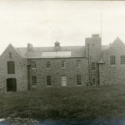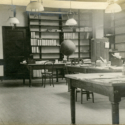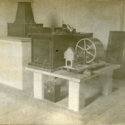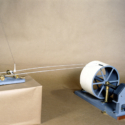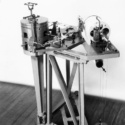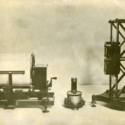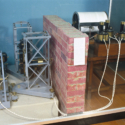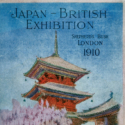Seismographs at Eskdalemuir Observatory, 1908–1925: tools for rethinking the origins of international cooperation in seismology
Abstract
https://dx.doi.org/10.15180/211607/001The British seismologist John Milne (1850–1913) is a dominant and celebrated figure in historical accounts of seismology. In this paper I use evidence from seismographs preserved in the collections of the Science Museum Group to reconsider his contribution, particularly to the progress of international collaboration in seismology. These instruments were installed at Eskdalemuir Observatory in Dumfriesshire, Scotland between 1908 and 1925; not only were they situated far from Milne’s private observatory on the Isle of Wight, but they represented examples of Russian, Japanese and German seismograph design as well as Milne’s own. No other site in Britain boasted such an international suite of earthquake instruments. Together, they reveal an alternative vantage-point from which to view his influence. By attending closely to the instruments’ provenance, I show how the collection can be a powerful tool for decentring the hagiography that surrounds the so-called ‘Father of Modern Seismology’.
Keywords
Boris Golitsyn, collections, Emil Wiechert, Eskdalemuir, Galitzin, John Milne, Ōmori Fusakichi, scientific instruments, seismograph, Seismology
Introduction
https://dx.doi.org/10.15180/Someone once remarked that ‘there is always a Father of Modern Seismology. To English-speakers his name is Milne, to German-speakers his name is Wiechert, to Russian-speakers his name is Galitzin’. All three were important in early seismometer design, but the historical importance of Milne in the development of global seismology gives Milne a superior claim to the title (Musson, 2013, p 792).
The more I pursue the life stories of actual objects…the more I find their biographies enrich, complicate and challenge traditional narratives (Pantalony, 2011, p 52).
The British seismologist John Milne (1850–1913) is a dominant figure in historical accounts of seismology. Authors have declared him a founding father of the discipline, celebrating his role in the development of instruments for detecting and recording earthquake waves, and in pioneering international cooperation in seismological science.[1] This paper examines seismographs preserved in the collections of the Science Museum Group to complicate this picture. These instruments – of Russian, Japanese and German seismograph design as well as Milne’s own – were installed at Eskdalemuir Observatory in Dumfriesshire, Scotland between 1908 and 1925. No other site in Britain boasted such an international suite of earthquake instruments. Together, they reveal an alternative vantage-point from which to view Milne’s influence. By attending closely to the instruments’ provenance, I show how the collection can be a powerful tool for decentring hagiographic narratives.
Accounts of the emergence of seismology as a scientific discipline draw attention to factors including the development of precision instrumentation and the establishment of specialised journals and scientific societies (Valone, 1998, p 747), and intellectual paradigms of the character of the Earth (Brush and Gillmoor, 1995, pp 1953–1954). Many authors have noted the different ‘national styles’ of seismological practice that coexisted in the late nineteenth and early twentieth centuries (Doel, 2003; Clancey, 2006; Oldroyd, 2009; Coen, 2013; Warner, 2015). Yet when reviewing the historiography of geology almost 20 years ago, David Oldroyd noted a focus upon ‘great men’ (Oldroyd, 2003, p 89), and despite growing attention by cultural historians in recent decades, this persists somewhat in histories of seismology. It is particularly evident in accounts written by ‘scientist-historians’, as Oldroyd terms scientists writing the history of their own discipline. Charles Davison’s Founders of Seismology (1927) set an early precedent echoed in more recent accounts, including those of Robert Muir Wood (1988) and Roger Musson, quoted above.
Nationalistic considerations shape the anointing of founding fathers. Declaring John Milne a founder of ‘global seismology’, as Musson does, is itself a partisan claim, not least since the majority of his instruments were installed within the British empire (as argued by Schweitzer, 2007, p 263, p 270). Lofty claims for Milne’s eminence were made first upon his death – with specific ends in view. Milne played a key role in coordinating a British-administered network of seismograph stations located around the world that enabled shock waves from distant earthquakes to be observed, collated and analysed. When he died in 1913, the future of the network was threatened. In obituaries, Milne’s contemporaries celebrated him, but also called for urgent funding and support to maintain the infrastructure. Against the backdrop of pre-war geopolitical tensions, some even expressed fears the scheme would be ‘captured by Germany’ (quoted in Anon, 1913); this referred to the activities of the International Seismological Association (ISA), run from Strasburg. As Mark Walker stresses, nationalistic agendas pervade trans- and international scientific projects (Walker, 2012); this paper will demonstrate some of the ways in which such agendas shaped seismological practice.
Bearing these considerations in mind, Eskdalemuir Observatory’s seismograph room represents an intriguing counterpoint. Between 1908 and 1925, it housed seismographs designed by the seismological ‘founders’ mentioned in the epigraph above: John Milne, German Emil Wiechert, and Russian Boris Golitsyn. In addition, a further device was installed, designed by Japanese seismologist Ōmori Fusakichi. No other observatory in Britain at the time boasted such an international array of earthquake instrumentation. Despite this, Eskdalemuir features little in historical accounts of seismology in Britain, receiving only a passing mention even in Musson’s exhaustive survey of seismology in Britain (2013). Lee Macdonald’s recent study of Kew Observatory explores the political, scientific and administrative factors that led to Eskdalemuir’s establishment, but he does not dwell on the seismological work done there (2018). The same is true of the compilation commemorating the site by former British Geological Survey scientist John Riddick (2003).
Of five seismographs that operated at Eskdalemuir in this period, four were ultimately acquired into the Science Museum’s collections, viewed by the curators as exemplary of instrument types. During their careers as museum objects, the instruments’ interpretation focused upon their technical attributes and mechanisms, with their operation and use at Eskdalemuir rarely mentioned in labels and catalogues. As the work of historians and curators has shown – including, amongst others, that of Sam Alberti (2005), David Pantalony (2011), Katherine Anderson (2019) and Alison Boyle (2019) – research which pursues the provenance of scientific instruments can illuminate the practices and processes of science. Anderson, in her study of the Oertling torsion balance, for example, draws attention to the value of ‘material and textual records that accrete around instruments, especially expensive ones’. Through these, she exposes the construction of so-called ‘global science’ from highly contingent observations made in specific locations (2019, p 27). In Pantalony’s paper that I quote in the epigraph above, he shows how the biography of the Theratron Junior radiation therapy unit in the collections of the Canada Science and Technology Museum contradicts the innovation-led exhibit narrative in which the artefact features, and compels us to challenge received views.
Looking closely at Eskdalemuir’s seismograph room and its international suite of seismographs provides a different perspective upon the origins of international cooperation in seismology, which more usually focuses upon the despatching of similar instruments around the world. As we will see, the circumstances of installing, operating and eventually decommissioning these instruments also presents a challenge to hagiographic accounts that glorify, often uncritically, the contribution of John Milne.
N.B. Голицын was historically romanised as ‘Galitzin’, and this spelling has persisted when referring to both the Russian seismologist and his eponymous instrument. In this paper I have used the modern convention for romanisation which spells the name ‘Golitsyn’, except in direct quotations.
The origins of the British Association seismograph network and the International Seismological Association
https://dx.doi.org/10.15180/211607/002In 1889, German astronomer Ernst von Rebeur-Paschwitz was attempting to detect the subtle influence of the Moon on the shape of the Earth, when his sensitive apparatus registered an unexpected disturbance. He later attributed this to an earthquake that had originated in Japan – a claim suggesting the possibility of studying earthquakes from anywhere in the world. Early in 1895, Rebeur-Paschwitz published proposals for an international network of around ten seismograph stations, centred on Japan and stretching out across the globe, hoping that observing the propagation of earthquake waves from seismically-active regions would shed light on the nature of the Earth’s interior (Westermann, 2011, p 55; Cremer, 2001, p 70).
Rebeur-Paschwitz’s findings generated much excitement amongst British scientists interested in earthquakes. Within the British Association for the Advancement of Science, the Earth Tremors committee – primarily concerned with small and local earth movements in Britain – invited the astronomer to recount his findings in their report (British Association for the Advancement of Science, 1894, pp 309–334). Meanwhile, John Milne, the British geologist and mining engineer engaged by the Japanese government as a foreign expert at the Imperial College of Engineering in Tokyo, described the observations within the journal he edited (Milne, 1893).
Rebeur-Paschwitz’s proposals for a seismic network won support from British scientists (including Milne) as well as those from France, Italy, Spain, Austria, Switzerland, Turkey, Russia and Japan (Cremer, 2001, p 71). However, illness prevented Rebeur-Paschwitz from presenting his scheme as planned to the International Geographical Congress in London in 1895 (Fréchet and Rivera, 2012, p 334). His correspondent and collaborator Georg Gerland, Professor of Geography at the University of Strasburg, did so in his stead and won unanimous approval. One British delegate enthused: ‘…there are hardly any phenomena so widely distributed as earthquakes, and their study is one which can only be treated as an international subject. I am well pleased, therefore, that a matter of such great importance should be brought forward at an English Congress’ (Keltie and Mill, 1896, p 767).
Rebeur-Paschwitz died only months later. Milne returned from Japan the same year, settling in the small village of Shide on the Isle of Wight. Backed by a reconfigured British Association committee he seized the initiative and began to coordinate a seismograph network himself. Utilising the administrative resources of the Colonial Office, India Office and Foreign Office as well as personal networks, Milne and the committee recruited observatory directors and other scientific practitioners to the project. Allegedly several potential instruments were considered, though it was a horizontal pendulum of Milne’s design that was quietly approved (British Association for the Advancement of Science, 1896, p 182; British Association for the Advancement of Science, 1898, p 137). By the time Milne reported to the British Association in 1898, 20 seismographs had been despatched from the London workshop of R W Munro (British Association for the Advancement of Science, 1899, pp 180–185). Observations were returned to Shide for collation and dissemination.
Meanwhile, Gerland continued to implement the scheme he had helped to initiate. He secured funding from the German Reich to construct a central earthquake station at Strasburg, which began operation under his directorship in 1900. Gerland’s dogged pursuit of his goals ruffled feathers, including amongst his fellow professors at Strasburg who complained they had not been consulted over the construction of the new institute. Indeed, Strasburg, boasting little existing tradition in earthquake research, appeared to many German and foreign scientists a questionable scientific site for such a station (Cremer, 2001, pp 63–76, p 114). Aided by the German government, Gerland convened international conferences and appealed to individuals and institutions that might host seismographs.
Numerous personal and national interests complicated progress towards the new organisation. In Britain, Milne was hostile to this project which threatened the influence he enjoyed in the field. In the wake of a second international seismological conference in 1903 he appealed to the Foreign Office to resist the ‘subordination’ of Britain’s scheme within a German-administered organisation.[2] Many of Milne’s peers found his stance frustrating, with even his closest allies struggling to endorse his behaviour. Geologist John Wesley Judd later conceded that some ‘may suggest that Milne was wanting in sympathy with the work of co-ordinating the results of other organisations than his own; and it may be admitted that his Pegasus did not run well in harness’ (Judd, 1913, p 588).
The Royal Society regretted that the proposals had not been shared via the International Association of Academies – their objection unsurprising given the influence they enjoyed within this transnational cartel (see, for example, Alter, 1980).[3] The International Seismological Association (ISA) was nonetheless officially founded in 1904 as an alliance of 17 states.[4] Britain remained ambivalent, sending delegates to participate in the international conferences but only formally joining the association in 1906. France joined the same year, their objections principally relating to the politically-charged location of the central bureau in Strasburg.[5]
The ISA collapsed during the First World War when its ten-year convention, passed in 1905, expired. A new International Association of Seismology was configured under the International Union of Geodesy and Geophysics, founded in 1919 (Rothé, 1981, pp 913–914).
Eskdalemuir Observatory
https://dx.doi.org/10.15180/211607/003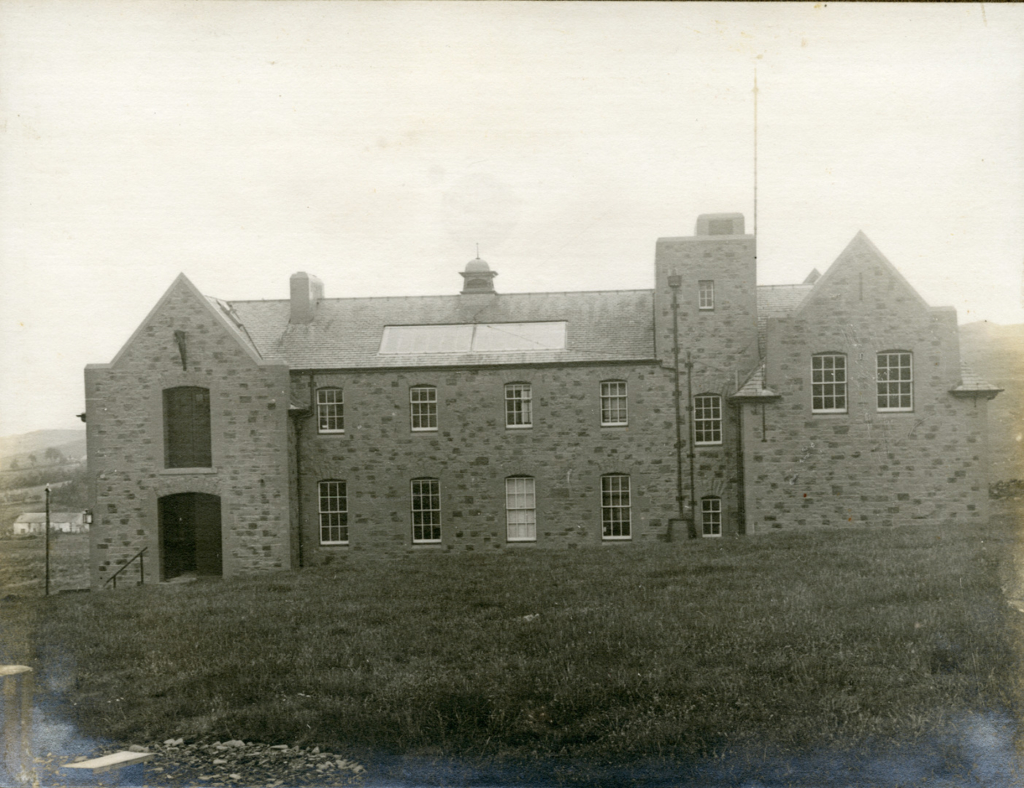
When the construction of an electric tramway disrupted magnetic readings at Kew Observatory on the outskirts of London, an alternative site had to be found for these observations. The £10,000 compensation from the tramway company supported the construction of a new facility in south-west Scotland, deemed suitably free from major causes of magnetic disturbance, whilst being sufficiently accessible (Blackwell, 1958, p 129). However, from the moment operations began at Eskdalemuir in 1908, the observatory had a broader remit than these events suggest, following the pattern set by Kew.
As Lee Macdonald (2018) has shown, intertwined financial, administrative and scientific factors shaped the character of observatory sciences at Kew, and resulted in the mix of activities undertaken there. Like many observatories Kew had diversified and then specialised over the course of the nineteenth century; nonetheless, by 1900, the site continued to be a centre of both geomagnetic and meteorological observations in addition to fulfilling the commercial instrument standardisation work that had become its core function. It was formally administered by the Kew Committee of the Royal Society until 1900, when the National Physical Laboratory (NPL) assumed responsibility. However, Kew was also a principal observing station and central observatory of the Meteorological Office, who supported this work with a grant. Additionally, the proceeds of the Royal Society’s Gassiot Fund facilitated daily meteorological and magnetic observations.
Though initially conceived as a site for magnetic observations, Eskdalemuir’s character was shaped by the involvement of the Meteorological Council, the governing committee of the Meteorological Office. This had followed a recommendation from physicist Arthur Schuster, who had highlighted the close connections between geomagnetism and meteorology. Schuster’s influence, that of the Council and the Royal Society, saw Eskdalemuir forged in Kew’s image, as a multifunctional observatory site, albeit lacking standardisation facilities: it was furnished for meteorological and atmospheric electrical observations as well as for terrestrial magnetism (Macdonald, 2018, pp 208–219). Like Kew, it also had a separate ‘seismograph room’.[6]
By the time George W Walker was appointed Eskdalemuir’s superintendent in 1908, further administrative shifts were in train that would see the new observatory, along with Kew and Valencia (now usually spelled Valentia) in Ireland, brought under the full jurisdiction of the Meteorological Office. Several factors precipitated this, most especially the scientific ambitions of Meteorological Office director William Napier Shaw. Shaw was frustrated of the lack of control he had over his central observatory, and the preference of National Physical Laboratory director Richard Glazebrook to transfer Kew’s calibration work to his own Teddington site (Macdonald, 2018, pp 220–221). In July 1910 the running of the three observatories officially became ‘a joint enterprise of the [Meteorological] Office and the Royal Society’. Funding continued to be supplemented by the Gassiot Fund, with the Royal Society’s reconfigured Gassiot Committee overseeing the observatories’ scientific agendas – specifically ‘the maintenance of…magnetic, seismological, or other meteorological or geophysical observations and researches’ (Meteorological Committee, 1911, p 42).
To some, including seismology within the purview of Eskdalemuir and the Meteorological Office was both natural and desirable. Shaw celebrated the ‘evolutionary’ process which had ‘terminate[d] the isolation of seismological and magnetic work’ (quoted in Gold, 1910, p 150). Schuster, whose department at Manchester was one of the few schools in the country cultivating research across a broad suite of topics in terrestrial physics, must also have found this arrangement satisfactory; he had previously voiced his frustration at the ‘inadequate provision’ made in Britain for the various strands of ‘geo-physics’ (Good, 2000, p 275; Schuster, 1906, p 259). Others were less convinced. A writer in the Meteorological Magazine conceded that while magnetic work might be justified at a meteorological observatory due to its bearing upon atmospheric dynamics, ‘a question may arise as to what could reasonably be excluded from meteorology if every influence which affects the upper atmosphere…were to be included’ (Anon, 1910a). The 1910 observatory report moved to placate such critics, stating: ‘there are indications that seismological observations may in the near future be utilised for purposes of weather forecasting’ (Meteorological Committee, 1910, p 19).
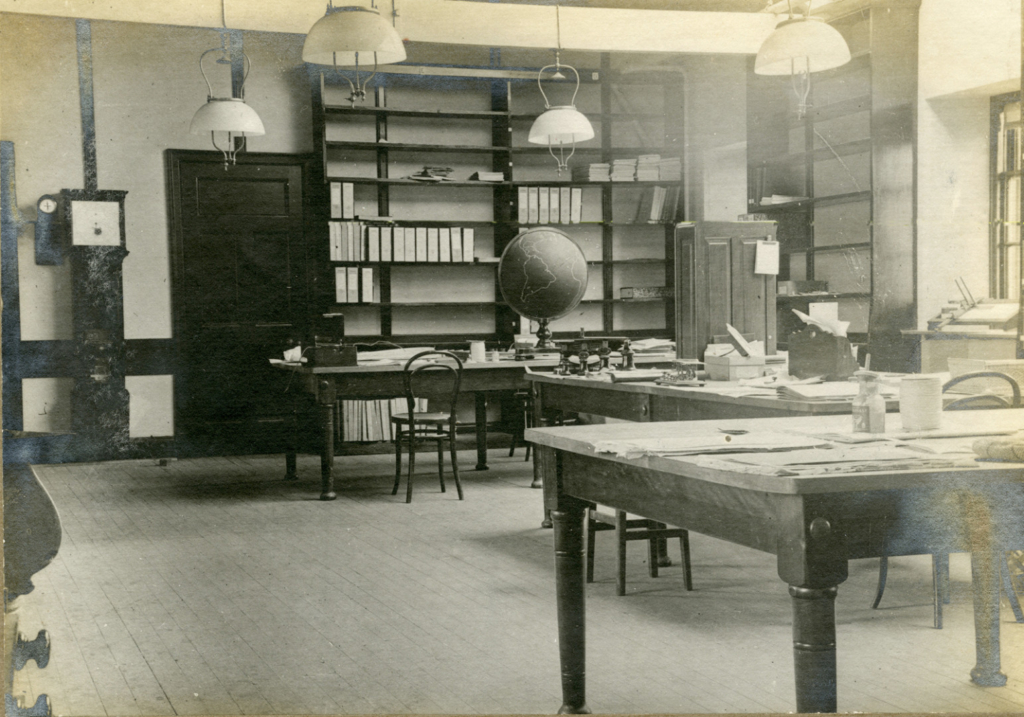
While seismological observations were apparently never used to this end, five seismographs were operated at Eskdalemuir over the following two decades, until, in 1925, the Meteorological Office’s seismological function was transferred to Kew.
Eskdalemuir’s seismographs
https://dx.doi.org/10.15180/211607/004Milne twin-boom horizontal pendulum, no. 52
The first seismograph to be installed at Eskdalemuir was a horizonal pendulum instrument of Milne’s design. The ‘twin boom’ machine could register both east-west and north-south components of earth motion. Constructed in 1908 and commencing operation the following year, it was the 52nd such instrument to leave the R W Munro workshop (British Association for the Advancement of Science, 1909, p 61; National Physical Laboratory, 1909, p 14). Although this might seem to speak to the instruments’ quality and success, and that of Milne’s seismograph network, two factors make this a more surprising decision than it might at first appear.
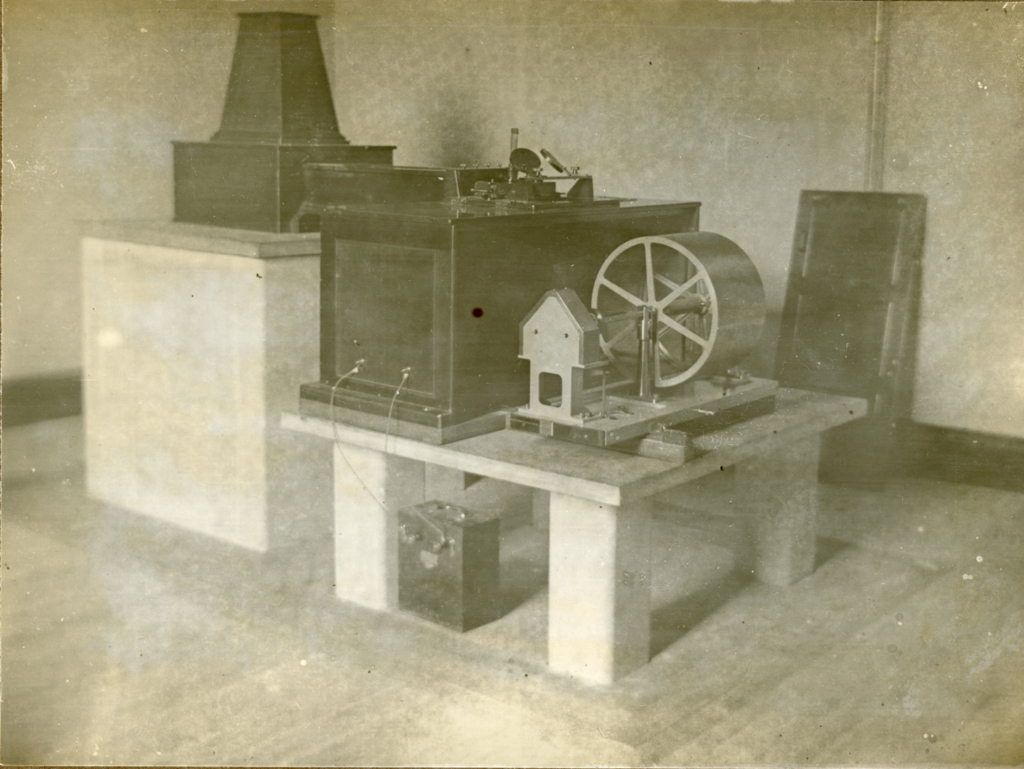
Firstly, Milne was apparently sceptical about the value of Eskdalemuir as a site for seismology (Musson, 2013, p 823)[7]; despite the exhaustive accounts of new stations in the seismological network in his reports to the British Association, he paid only cursory attention to the Eskdalemuir instrument (British Association for the Advancement of Science, 1909, p 61; British Association for the Advancement of Science, 1911, p 44). Given that the chief strength of the British network was its geographical spread – valuable for the accurate determination of earthquake centres – there was arguably limited scientific benefit to another instrument in such close proximity to existing British stations. Additionally, vibrations caused by the frequent high winds blowing from the North Atlantic were prone to disturbing sensitive seismological hardware. Despite an initiative to plant trees on the site to offer some shelter,[8] in 1913 the observatory report noted that for this reason ‘the tabulation of earthquakes in the winter months’ was ‘rendered difficult and in some cases impossible’ (Meteorological Office, 1915, p 98).
Secondly, Milne’s seismograph had significant technical flaws. These were acknowledged candidly after his death in 1913: in reports to the British Association, former Eskdalemuir superintendent Walker and seismological committee chairman Herbert Hall Turner detailed a litany of issues with the instrument, particularly its low magnification and lack of damping. This resulted in frequent errors in interpreting its records. Turner claimed that in relation to the 1913 determinations of arrival times for P waves – the compression waves that travelled most rapidly through the Earth – only between 25 per cent and 40 per cent could be said to be ‘true readings’, much lower than for other seismograph designs (British Association for the Advancement of Science, 1915, pp 46–69, especially pp 52–53).
Yet it seems some of Milne’s peers voiced concerns long before this, since he was frequently moved to defend the device in his reports to the British Association. Even in 1898, when he visited the new seismological station at Strasburg, Milne downplayed the merits of the alternative instrument designs he saw there, some of which were more sensitive than his own; he reassured the committee that although each instrument had its own merits, there ‘did not appear to be any necessity to regret the choice which they have made’ (British Association for the Advancement of Science, 1899, p 272). The following year, he expressed the ambivalent claim that the device yielded ‘results sufficiently accurate for the main objects in view’ (British Association for the Advancement of Science, 1900, p 60). Likely prompted by growing concerns from the British Association seismological committee, he conducted a detailed comparison with Strasburg’s Rebeur-Ehlert pendulum, acknowledging the ‘comparative want of sensibility’ of his instrument but defending its accuracy, the fineness of its trace, and its more economic consumption of photographic paper (British Association for the Advancement of Science, 1904, p 83). Nonetheless, the report of seismological observations at Kew in 1903 hints at the difficulties of interpreting the Milne instrument’s records. Of the 22 disturbances, six were annotated with remarks that the timing of the preliminary tremors was not clear, or which questioned whether the disturbance was seismic in origin at all (National Physical Laboratory, 1904, p 52).
With all this in view, I argue that the decision to install the Milne horizontal pendulum at Eskdalemuir was a calculated, strategic and politically-motivated move. As noted above, it was not self-evident that seismology should be included within the programmes of the Meteorological Office’s observatories; this was due, in substantial part, to the interests and campaigns of Shaw and Shuster. Milne’s opposition to the ISA may have antagonised some of his peers, but nonetheless he had a wide-reaching network of allies and collaborators in Britain and overseas. He had also cultivated a significant public profile through writing and lecturing. Significantly, too, he amply supplemented the limited British Association grants for seismological work from his own pocket – a fact brought into sharp focus upon his death in 1913 (as discussed, for example, in British Association for the Advancement of Science, 1915, pp 41–42). These factors contributed to the dominance of Milne’s horizontal pendulum seismograph in Britain, and the resulting research programme that Greg Good has argued coalesced around the instrument (2000, p 285). Selecting another seismograph for Eskdalemuir risked antagonising Milne, whereas installing his device drew him into the observatory’s network of collaborators.
A new design of recorder developed by maker Munro increased the speed of the recording drum to improve the registration of preliminary tremors.[9] Even so, Eskdalemuir staff struggled with the instrument’s faults, reporting in 1913 that they had attempted a modification by fitting an oil-based damping mechanism to one of the booms. This had exacerbated other problems, however: ‘the results were not promising owing to the loss of sensitivity incurred’ (Meteorological Office, 1915, p 100).
Although Milne was broadly successful in quieting public criticisms of his horizontal pendulum design during his lifetime, after his death support for the instrument collapsed. Even as his friends penned gushing tributes and calls to preserve his seismological scheme, the British Association committee immediately actioned a succession plan for the problematic devices. Within weeks, chairman Herbert Hall Turner had written to the network’s participating stations with the joint objective of cajoling them to continue their observations, but also to invite their cooperation in upgrading the network’s hardware.[10]
Less than a year later, during 1914, operation of Eskdalemuir’s Milne instrument ceased (Meteorological Office, 1916, p 118). As we will see below, the observatory also played a significant role in demonstrating the efficacy of an alternative seismograph and thus expediting the obsolescence of Milne’s design. Additionally, evidence relating to the other seismological instruments installed at Eskdalemuir indicates how the Milne seismograph was seen by scientists and administrators as being necessary, but certainly not sufficient, for their plans for their observatory.
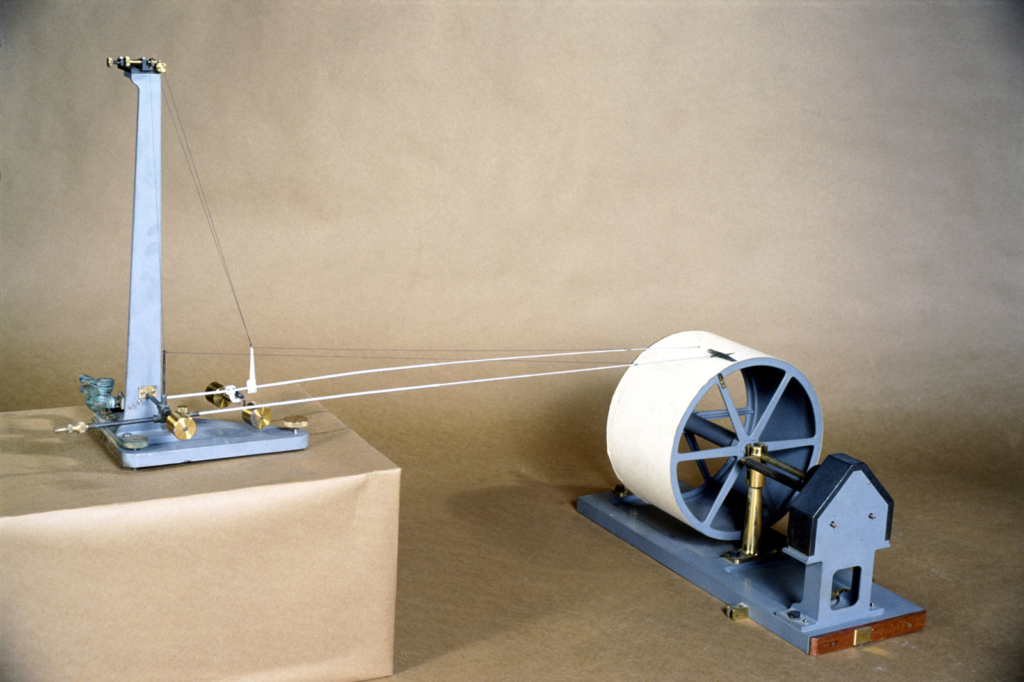
Wiechert inverted pendulum seismograph
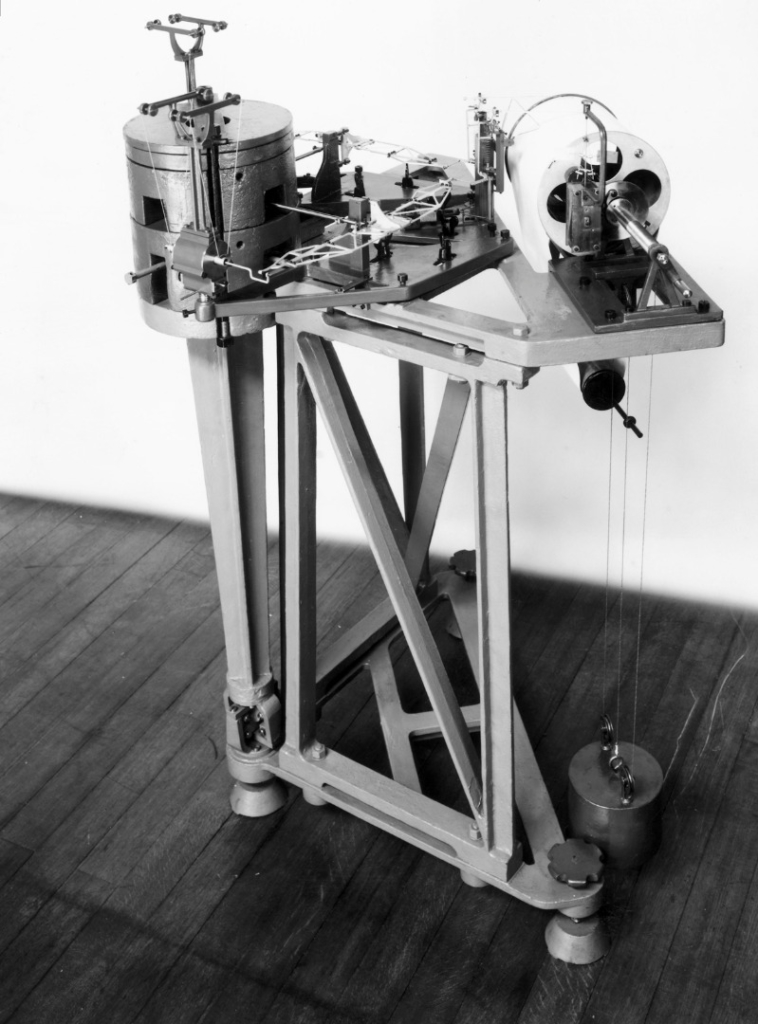
In 1909, the Eskdalemuir staff installed a Wiechert inverted pendulum instrument on what they termed the ‘experimental pier’ of the seismograph room (National Physical Laboratory, 1910, p 50). The instrument’s heavy mass sat atop a pillar pivoted at its base, and held in position by a system of springs. Unlike Milne’s instrument, the Wiechert design was damped, with air pistons preventing the pendulum’s own resonance from interfering with the recorded motion. Its smoked paper recording system yielded a finer trace than the photographic system with which Milne’s instrument was equipped. Friction between the stylus and the drum was mitigated using a counterweight (Shaw, 1936, p 78).
Emil Wiechert was professor of the geophysics institute at the University of Göttingen. A skilled instrument designer, his seismographs were adopted and championed by the ISA, with the 1000-kilogram model particularly celebrated (Cremer, 2001, p 129). The machines were built and marketed by Göttingen maker Spindler & Hoyer. Prior to the Eskdalemuir instrument, none had yet been installed in Britain (Lovell and Henni, 1999).
The funds were provided by the Gassiot Committee and Meteorological Office, but aspects of the installation and operation remain unclear from the sources consulted so far; I hope future research will shed light on these. One outstanding question is what – and who – motivated the selection of this particular seismograph. Plausibly Schuster advocated it, given his close relations with the ISA, although I have not yet found direct evidence of his influence. A further clue is suggested in the report of superintendent Walker to the Gassiot Committee in April 1910 that ‘the comparative observations on the results afforded by various forms of seismograph’ was to be continued.[11] It isn’t clear, however, whether this project motivated the installation of the Wiechert, or whether the value of this opportunity was recognised after its installation.
There is no doubt, however, that Walker was severely displeased with the instrument’s function. In a damning memorandum to the Gassiot Committee in 1910, he complained that ‘[t]he workmanship is very poor, and the frame…wanting in rigidity’. Furthermore: the method of marking time intervals on the record disrupted the tracing levers; friction between the styli and paper meant tremors of small magnitude were not recorded; and the azimuth could not be correctly determined since the two components did not operate independently. ‘The amount of work involved in keeping the apparatus running is very considerable,’ Walker concluded, ‘and seems to give no adequate return.’[12] The Committee apparently conceded, and soon afterwards operation was suspended (Meteorological Office, 1911, p 41). This was initially a temporary measure, but based on subsequent annual reports, it was used infrequently.
Two paradoxes present themselves from Walker’s testimony, however, and both invite further investigation. Firstly, in his memorandum he misdescribed the instrument as having a 200 kilogram mass; in the 1912 annual report and his 1913 textbook, he specified it as an 80 kilogram mass (Meteorological Committee, 1912, p 51; Walker, 1913, p viii). Spindler & Hoyer catalogues confirm that both sizes were manufactured, but there is no record of the instrument being altered or a new one procured, so Walker’s original account must have been wrong.[13] This might have been a simple human error, but it is an elementary one; how come he was so familiar with the technical details of the instrument’s faults, and presumably have played a key role in its purchase, and yet make this mistake? Another curiosity is that Walker should have found the instrument as unsatisfactory as he did, since in the decades to come, Wiechert seismographs would be championed by British scientists involved in the study of earthquake waves. Kew Observatory’s seismologist, Alwyn Walter Lee, declared it in 1939 ‘the most popular instrument’ that had mechanical (as opposed to photographic) registration (Milne and Lee, 1939, p 64). According to Cambridge geophysicist Harold Jeffreys, when invited to offer his opinion on the relative merits of instrument designs: ‘Far and away the best ordinary machine is the 1-ton Wiechert.’[14] Kew Observatory superintendent Francis Whipple recommended the design to enquirers from observatories worldwide during the 1930s, and claimed that the staff ‘frequently regretted that the Wiechert…went to the Science Museum instead of coming here’.[15] As acknowledged by the manufacturer, the lighter 80-kilogram instrument was less sensitive, but it remains unclear whether this alone was to blame for the challenges Eskdalemuir’s staff experienced.
Golitsyn seismographs
In 1910, the year after the Wiechert had been installed, Eskdalemuir’s seismological equipment was swelled further thanks to a donation by Arthur Schuster. Schuster viewed seismology as a constituent of the broad research programme of terrestrial physics he had cultivated at Manchester. Descended from a wealthy family of bankers, he was in a position to make a material contribution to further both his scientific interests and those of the Gassiot Committee (Howarth, 2004). He purchased for the observatory two seismographs designed by the Russian seismologist Boris Golitsyn; together, the instruments could register both horizontal components of earth motion. Two years later he donated a vertical seismograph. Without Schuster’s assistance, it seems unlikely such instruments would have been obtained for the observatory due to their considerable expense: in contrast with the relatively simple Milne device, costing approximately £50 or £60 depending on specification, a three-component Golitsyn suite was at least five times the price.[16]
In contrast to the mechanical systems of the Milne and Wiechert instruments, Golitsyn’s device registered earthquake waves electromagnetically: the heavily damped pendulum carried a coil of fine wire which moved within the field of a pair of horseshoe magnets. The slight motions of the pendulum were detected using a galvanometer, which reflected a beam of light from a lamp to the recording drum, upon which a trace was registered photographically.[17]
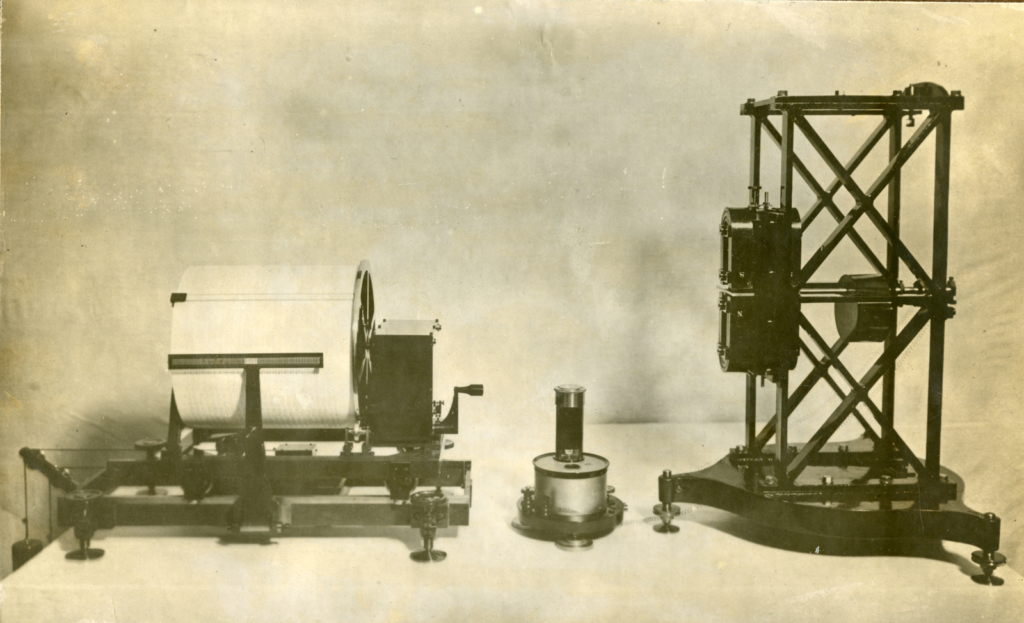
The horizontal instruments were installed ‘under the personal supervision’ of Golitsyn in July 1910. This high-profile visit also lured to the site John Milne, who to date had not engaged closely with the seismological activities at Eskdalemuir. Superintendent George Walker was delighted to report Milne’s interest to his governors (Meteorological Committee, 1911, p 43).
Walker described the new instruments for Nature, noting their use in Russia and rapid adoption by the ‘principal Continental observatories’ (W[alker], 1910, p 218). The cutting-edge hardware transformed the observatory’s seismological capability. While Milne’s instrument could do little more than indicate the arrival time of earthquake waves, the Golitsyns generated a more faithful record of the Earth’s motion, enabling detailed analysis of, for example, the amplitudes of different phases.[18] Also, significantly, they enabled observatory staff to locate an earthquake’s epicentre using the records from a single suite of instruments, as opposed to comparing records from instruments in different geographical locations, as was necessary with Milne and Wiechert seismographs.
The devices had downsides. As well as being expensive to purchase they also cost more to run, since they consumed more photographic paper. They also required more floor space in the observatory, and when they went wrong they generally needed expert attention. Additionally, making observations was a two-person job – and a skilled one. Even routine maintenance required ‘a working knowledge of algebra’; analysis of the records demanded ‘higher mathematics, and particularly elementary differential equations’ (British Association for the Advancement of Science, 1915, p 60). During discussions in the 1920s regarding the eventual transfer of the instruments to Kew, the then superintendent estimated that the minimum time required by an assistant to keep the instrument running was around 20 hours per month, but original research was impossible without a full-time seismological observer.[19]
Initially it seemed the instruments were well-suited to conditions at Eskdalemuir, where strong winds regularly interfered with the other seismographs. Walker reported that when winds exceeded 30 miles per hour, it was difficult to distinguish air tremors from small earthquakes using the Milne instrument. In contrast, ‘there is no difficulty in distinguishing which is which on the Galitzin records. The record of a small earthquake is totally different from the record of wind disturbance’ (Meteorological Office, 1911, p 41). This positive evaluation was subsequently tempered; in particular, the Golitsyns’ acute sensitivity to temperature variation plagued the staff, who had to continually adjust the pendulums to render observations viable (Meteorological Office, 1927, p 113).
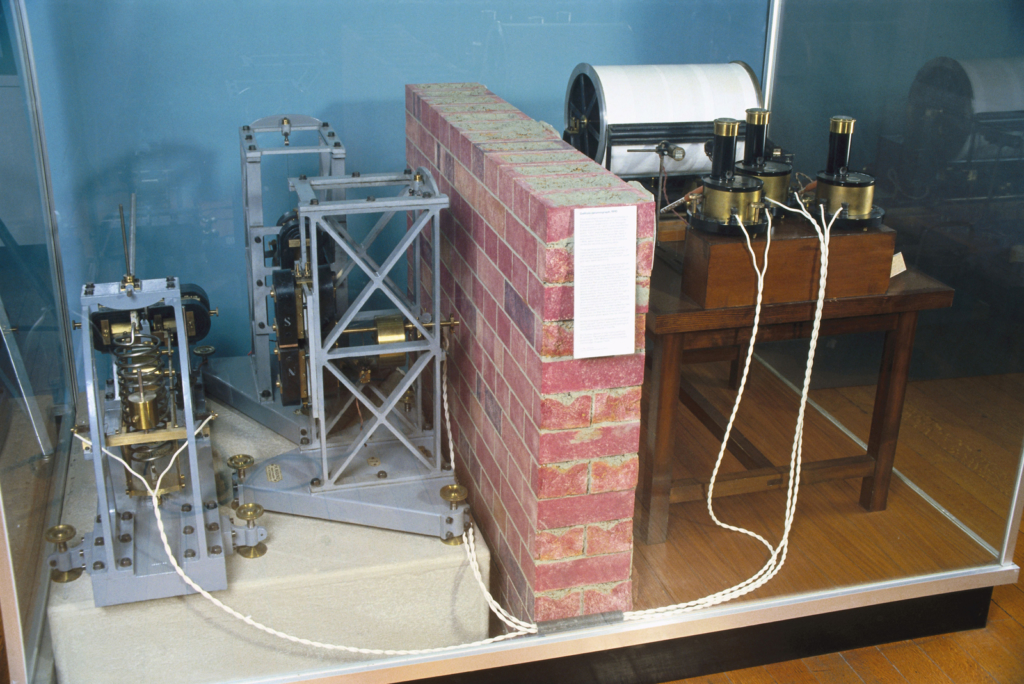
Ōmori seismograph no. 2
During 1911, the observatory acquired yet another instrument, this one designed by Japanese seismologist Ōmori Fusakichi. Ōmori had been a student at the Imperial University of Tokyo whilst Milne was stationed there, studying under Sekiya Seikei – the world’s first professor of seismology. After a spell continuing his postgraduate studies in Italy and Germany, Ōmori returned in 1897 to succeed Sekiya as professor and as secretary to Japan’s state-funded Earthquake Investigation Committee (Davison, 1927, pp 210–211). His research was broad-ranging and he was a prolific writer in both Japanese and English. His visit to California in the wake of the 1906 San Francisco earthquake had raised his profile further amongst the Anglophone seismological community.
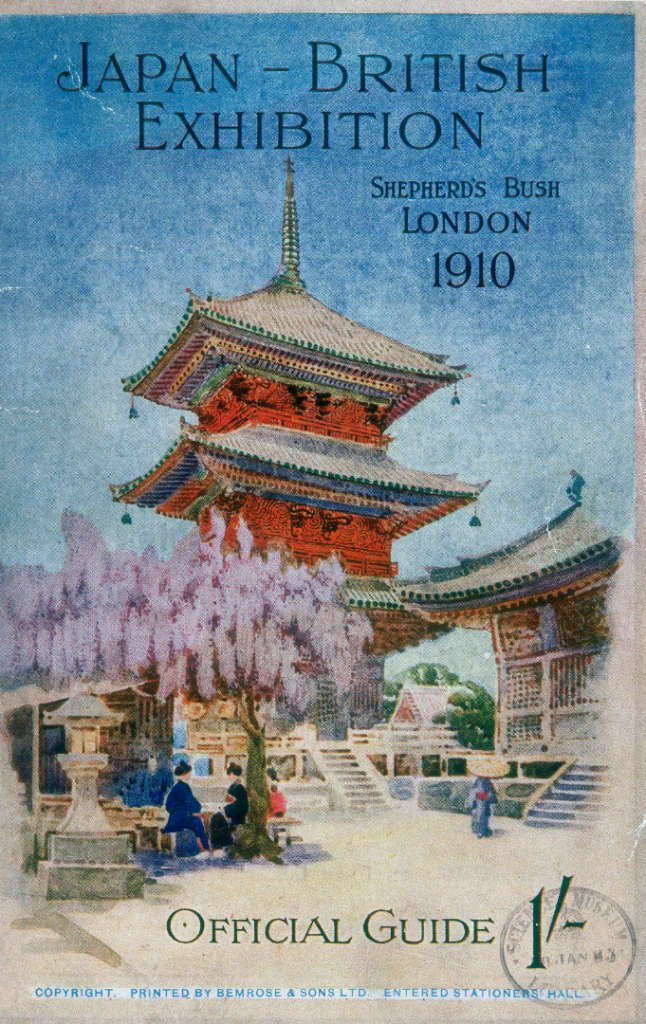
The summer of 1910 witnessed a flurry of enthusiasm for Japanese culture and industry in Britain. London’s White City hosted the Japan – British Exhibition, marking the renewal of the Anglo-Japanese Alliance. In July The Times published an article by Ōmori on ‘Seismology in Japan’, in which he highlighted the contributions of European and American practitioners in promoting the scientific study of earthquakes (Ōmori, 1910). British newspapers also acknowledged the publication across the Atlantic of a celebratory feature on Japanese seismology. American seismologist Thomas Jaggar was awed by the advanced state of earthquake research he had encountered in Tokyo (1910, reported in, for example, Anon, 1910b).
Seismographs based on Ōmori’s design were almost entirely absent in Britain. The only other known example was operated from about 1903 by teacher and geologist Charles Davison in Birmingham (Lovell and Henni, 1999). However, they were distributed widely elsewhere in the early decades of the twentieth century; researchers in 2004 traced more than 100 instruments in observatories around the world (Batlló et al, 2004, p 701–703). The most common model was one commercialised by Strasburg maker J. & A. Bosch brothers, who created an affordable instrument which both performed reliably and was relatively easy to operate. As Gregory Clancey has argued, this partnership likely benefitted Japanese seismologists as they actively sought closer alignment with the German-administered ISA rather than the British scheme (2006, p 170).
Eskdalemuir’s device was not a Bosch-Ōmori seismograph, however, but was an early model – only the second of its type – constructed in Tokyo in 1898. It combined a horizontal pendulum mechanism with an auxiliary inverted pendulum, the latter of which enabled fine adjustment, and employed a smoked-paper recording system (Wartnaby, 1957, p 30).
Ōmori no. 2 had been an exhibit at the Japan – British exhibition, exemplifying both Japanese innovation and the fruitful collaboration between scientific practitioners from both nations. Milne negotiated with Mano Bunji, the Japanese Commissioner and President of the Earthquake Investigation Committee, to arrange a two-year loan of the seismograph following its display, arguing that if installed at Eskdalemuir there would be an opportunity to compare four different instrument designs. This proposal met with approval from the Gassiot Committee, although may not have been pursued with the convenience of Eskdalemuir’s staff in mind; in spring 1911 Walker reported that ‘[a]rrangements for installing the apparatus at the observatory are still under consideration’ (Meteorological Committee, 1911, p 43). The following year, however, the additional labour of running this instrument alongside the rest of the suite prompted a £450 grant from the Royal Society to support a ‘Professional Assistant’ in seismology. Cambridge University student, L Southerns duly joined Eskdalemuir’s staff in 1912 (Meteorological Committee, 1912, p 10).[20] When the agreed two-year loan of the instrument expired, it was permanently gifted to the observatory by the Japanese Education Department who ‘accepted the present of an English watch in lieu of the return of the seismograph’ (Meteorological Committee, 1913, p 57).
Its early operation at the observatory was inauspicious. A major earthquake in 1912 was not recorded due to a defective multiplying lever; Milne supplied its replacement (Meteorological Committee, 1912, p 51). While data from the instrument were not regularly tabulated or incorporated into Eskdalemuir’s bulletins, the staff found the immediately visible smoked paper records a useful backup ‘in case of any loss of record given by the photographic recorders’; they also observed that particular types of earth movement – specifically ‘[l]ocal vibrations of a rapid nature’ – were more clearly registered by the Ōmori than the other instruments (Meteorological Office, 1915, p 98). On occasion the staff temporarily modified the device in order to carry out specific experimental work, including into small-magnitude microseisms (Meteorological Office, 1916, p 119).
Milne-Shaw horizontal pendulum no.3
As discussed above, the British Association quickly sprang into action after Milne’s death to replace the problematic horizontal pendulum instruments with a more suitable design. John Johnson Shaw, an amateur seismologist and close collaborator of Milne, had already designed a device based on the existing instrument but with higher magnification and an electromagnetic damping system; the British Association committee backed this approach as their best means of improving the quality of the observations. The so-called ‘Milne-Shaw’ device addressed the most substantial problems of the Milne pendulum whilst demanding few changes to operational procedures. In his circular to the network’s participating stations, Turner expressed his hope that some might be prepared to support this ‘advantageous new departure’ and purchase one of the updated instruments. He advised they should run it as an additional component alongside their existing Milne instrument so that a fair comparison between the seismographs could be obtained. Since Milne’s rapport with station operators had been critical in establishing the network in the first place, he stressed there had been no dissent between Milne and the committee: ‘The alterations were the outcome of discussions with Prof. Milne, and had his full approval.’[21]
Unsurprisingly, it proved challenging to persuade observatory personnel to invest time and money in a new and unproven instrument. Consequently, initially the only Milne-Shaw installations were in Britain, with the first at Bidston Observatory, near Liverpool.[22] Instrument no.3 was erected at Eskdalemuir in 1915, to test it against the Wiechert and Golitsyn machines. The committee deemed its performance satisfactory, generating a record which was ‘strictly comparable’ with the latter instrument – albeit by giving a measure of the amplitude of ground movement, rather than of velocity as did the Golitsyns’ galvanometers (British Association for the Advancement of Science, 1916, p 57, p 77). Testing complete, the following year the committee were unequivocal about their priorities:
It is submitted that the most important work of the Committee for the present lies in replacing the Milne machines, either (where possible) by Galitzin machines or (where the expense of Galitzin machines, both capital and working expenses, is judged too great) by M-S machines (British Association for the Advancement of Science, 1917, p 32, emphasis in original).
Unlike Eskdalemuir’s other seismographs from this period, Milne-Shaw no.3 was not ultimately transferred to the Science Museum’s collections. With its intended experimental function at Eskdalemuir completed, it was relocated to the Royal Observatory in Edinburgh in 1919 (British Association for the Advancement of Science, 1920a, p 216), and later acquired by the Royal Scottish Museum (now National Museums Scotland).[23]
Eskdalemuir and international seismological cooperation
https://dx.doi.org/10.15180/211607/005Tracing the biographies of these instruments reveals that Eskdalemuir was a unique seismological site in Britain thanks to its international suite of seismographs. More than this, however, the choices made relating to instrument selection, and the routes by which they came to be installed in the observatory, are suggestive of underlying political agendas of Britain’s seismological practitioners. Within Eskdalemuir’s seismograph room, the influence of personal and nationalistic agendas upon international collaborations comes into sharp focus.
John Milne’s hostility to the fledgling ISA project arose from his fears that it threatened the status of the British Association’s seismograph project, upon which he had staked his entire career and reputation. From the earliest international conferences, this antagonism placed him at odds with some of his peers, even within the seismological committee. In 1909, one of the British Association’s general secretaries lamented the ‘unfortunate dispute’:
On the one hand [George] Darwin and [Richard] Glazebrook aver that Milne will have nothing to do with the International Committee, thinking it wishes to use his material and an investigation which he originated, and that he puts obstructions in the way of that Committee. [John] Perry and Milne throw the blame on the International Committee and think that Milne, who has made earthquakes his life-long study, should be allowed to continue his investigation by himself without any interference from the International Committee.[24]
Milne’s objections were longstanding. He had attended the 1903 international conference at Strasburg, along with fellow committee member George Darwin, and both men submitted memoranda to the Foreign Office after the event. Darwin expressed reservations about the proposed scheme’s limited funding, and the inefficiencies of its organisation. However, he advocated Britain’s involvement, both because of the scientific benefits that would ensue from ‘a better co-ordination’ of seismological work, and because he believed that ‘British interests will be better protected by our joining the Association than by our standing aloof’.[25] In contrast, Milne strongly opposed the locating of the central bureau at Strasburg – a site ‘without any seismological organization’. He appealed to the government’s vanity by highlighting their involvement in Britain’s seismological network, and, before this, the installation of a seismograph of British construction in Tokyo in the 1880s, during his own tenure in Japan:
When we remember that the first attempt to obtain International co-operation was made through H. B. M.’s Minister the late Sir Harry Parkes and the Japanese Foreign Office in 1883 and that the existing co-operation was obtained largely in consequence of the action taken by the Foreign Office, the Colonial Office and the India Office in 1897, it seems doubtful whether all the existing members of this body would regard the subordination of their present centre as desirable.[26]
Arthur Schuster was also a key voice in these unfolding discussions. He was vocal and active champion for international cooperation in science, which he believed could be an instrument of peace; he particularly believed that terrestrial physics was a key domain in which such cooperation could fruitfully be cultivated. As he argued in a Friday Evening Discourse at the Royal Institution in 1906:
The cooperation of different nations in the joint investigation of the constitution of the terrestrial globe, of the phenomena which take place at its surface, and of the celestial bodies which shine equally upon all, directs attention to our common interests and exposes the artificial nature of political boundaries (Schuster, 1906, p 259).
While he praised the British Association’s seismological scheme, he noted that ‘the needs of different countries are not, and were not meant to be, completely satisfied by this organisation’. He begged to express his personal view that ‘the permanent interests of this country would be best secured by our joining the [International Seismological A]ssociation and helping to direct its work in a manner which would assist rather than hamper the present organisation of the British Association’ (1906, pp 257–258). The previous year, Schuster had been offered the presidency of the ISA in an attempt to secure Britain’s involvement. He had declined, apologising to a Reich government representative that the threat Milne perceived to the independence of his work presented a substantial obstacle (Cremer, 2001, p 122). However, he was forthright to his peers at the Royal Society. ‘If we refuse to join we may stand alone’, he stressed, as France and the United States seemed poised to confirm their affiliation. At the same time, he argued for greater financial support for the British Association’s network, and the safeguarding of the status of Milne’s Shide observatory by insisting that Milne deal with all correspondence between the ISA and stations within the British Empire.[27]
This crucial context illuminates both the acquisition of a Milne horizontal pendulum as Eskdalemuir’s first seismograph – a signal of allegiance to Britain’s home-grown seismological scheme, despite the known faults of the device – and the rapid adoption of alternative instruments which were preferred by the ISA.
Furthermore, Schuster carefully choreographed the installation of the vertical Golitsyn seismograph that he donated to the observatory in 1911, so that it would serve as a public statement of Britain’s commitment to the international project. Manchester, the site of Schuster’s university, hosted that year’s international conference, and the newly-designed vertical component was exhibited at the meeting before its presentation to Eskdalemuir. During the conference, delegates made the lengthy journey by rail and road to tour the observatory (Meteorological Committee, 1912, pp 51–52). While there, they saw the two-component Golitsyn operating alongside Milne’s instrument. This visit emphasised that Milne’s Shide observatory was not the sole nexus of seismological activity in Britain, and that observations in Britain were made with cutting-edge instruments that had emerged from other nation’s research programmes.
It is unlikely to be a coincidence that Milne began to publicise the visitors he had received at his own observatory at around the same time; from 1910, these exhaustive lists of British and international guests became part of the regular preamble to the reports he submitted to the British Association. Viewed in this light, his efforts in arranging the transfer of the Ōmori seismograph to Eskdalemuir might also be seen as a reaction against Schuster’s agenda towards closer affiliation with the ISA, and an act of self-promotion. The instrument, after all, was not a cutting-edge design, being already 13 years old by the time it was delivered to Scotland. Additionally, given Milne’s reservations about the scientific value of the site, he might easily have chosen to install the instrument at Shide instead where he could oversee its operation. Yet at Eskdalemuir, the Ōmori seismograph served as a persistent physical reminder to Schuster, the observatory staff, and the members of the Gassiot committee of Milne’s connections with the Japanese government, and the extent to which his influence had shaped Britain’s seismological practice.
Conclusion
https://dx.doi.org/10.15180/211607/006By 1921 the Golitsyns were the only instruments still in operation at Eskdalemuir (Wood, 1921, p 435). In 1925, at the proposal of the Director of the Meteorological Office, George Clarke Simpson, the instruments were transferred south to Kew; Simpson argued that Kew ‘offered greater facilities for the regular working of these seismographs, and for dealing with the results obtained’.[28] This suggestion that limited staff resources had hindered the seismological work at Eskdalemuir is corroborated by the testimony of Superintendent Alexander Crichton Mitchell, who emphasised the substantial time required for original research or analysis of the records, in comparison to routine seismological observations.[29] In addition, the wind’s interference with the seismographs at Eskdalemuir likely contributed to arguments for their removal. For all the sophisticated hardware which had supposedly equipped the station to pinpoint earthquakes occurring anywhere around the globe, local factors stymied the enterprise.
The retired Wiechert, Ōmori and Milne instruments languished at Eskdalemuir until their transfer to the Science Museum in 1928. The Meteorological Office staff, delighted to be rid of the unwieldy devices, loaded them aboard a southbound train at the first opportunity, declaring them a ‘free gift’ to the Museum.[30] The Golitsyns joined the Science Museum’s displays in 1966, when Kew’s seismological operations were themselves wound down. Eskdalemuir became a seismological site once again from the 1960s as a node in the World Wide Standardized Seismograph Network, which provided global seismic monitoring for the detection of nuclear tests (Truscott, 1964).
The acquisition of the instruments by the Museum aligned with curatorial efforts to increase the representation of different types of seismological apparatus in the displays. In line with conventions of the time, object labels and catalogue descriptions concentrated on mechanisms and underlying technical principles. As can be seen from both John Wartnaby’s Seismology catalogue (1957) and Anita McConnell’s Geophysics & Geomagnetism (1986), subsequent curators persisted in interpreting these instruments as exemplars of different designs. As David Pantalony observes, ‘historians and curators have traditionally treated the history of scientific objects on very general terms, as archetypes, while ignoring the actual history of an artefact – who used it, where it was used, who made it, and even its museum history’ (2011, p 52). In the case of these seismographs, the history of their installation and use was deemphasised within the Science Museum’s interpretation and display, with the fact that they were at Eskdalemuir receiving at most a passing mention.
As Pantalony demonstrated with the Theratron Junior, attending to the life stories of museum artefacts – and looking beyond their conventional interpretation within displays and catalogues – opens up new avenues of research and new ways in which museum collections can enhance (or indeed challenge) histories of science and technology. Although, as he acknowledges, museums frequently ‘shy away’ from this style of ‘micro-history’, such provenance research ‘should serve as inspiration to develop new themes for science and technology museums, themes with a broader cultural outlook and potentially fruitful cross-fertilizations’ (2011, p 63). In her study of the Oertling torsion balance, Katharine Anderson demonstrated how insights from provenance research ‘serve the historian…as markers of large themes’ in relation to the emerging discipline of geophysics in the inter-war period. In particular she notes ‘how often the nationalist and internationalist aspects of the earth sciences were in a state of tension’ (2019, p 27), an observation that applies equally to the themes of this paper.
Noting Pantalony’s call and following Anderson, I have sought to demonstrate in this paper how Eskdalemuir’s instruments were recruited by members of Britain’s seismological community for agendas that were acutely political as well as scientific. The assembly of a uniquely international suite of seismographs by Schuster and the Gassiot Committee did important diplomatic work at a time when Britain’s relations with the international seismological community was strained. This case study indicates that close studies of instruments can be a tool for decentring the dominant hagiographic narrative of seismology in Britain, which champions John Milne as a founding father and pioneer. While Milne certainly played an important role in the seismological activity at Eskdalemuir, his influence was more nuanced than heroic narratives allow. In turn, we have seen the contributions of other actors, particularly Arthur Schuster, come into sharp focus.
This close study of a small suite of instruments in a single Scottish observatory is a starting point that suggests further research questions. When and how was a ‘global’ science of seismology forged – and how might object-focused methodologies shed light on this process? How was John Milne’s reputation as a founding father of seismology constructed and perpetuated, including within the collections and displays of the Science Museum – and to what extent can these same collections be used further to decentre this hagiography? These are questions I hope to address in future research.
Acknowledgements
Thank you to Graeme Gooday for his feedback on an early draft of this article, and to both anonymous reviewers. This paper draws upon research I am conducting in relation to my doctoral research at the University of Leeds.


